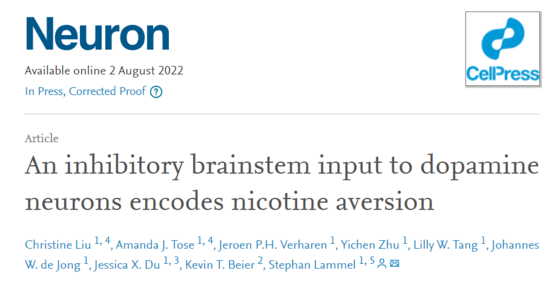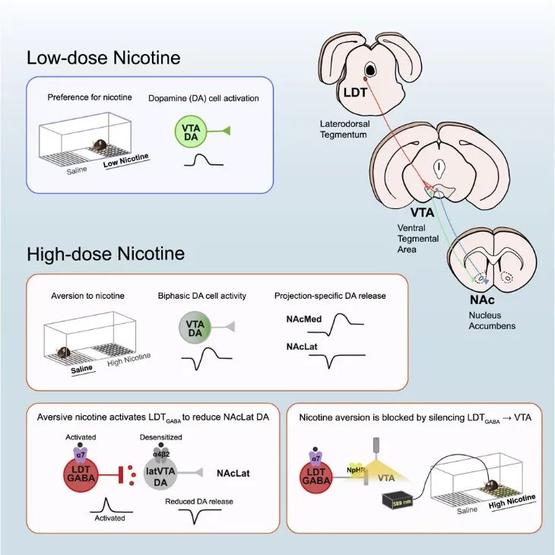If you remember how you felt when you first smoked, you know how disgusting nicotine can be. However, for many people, the high nicotine intake outweighs the negative effects of excessive intake.
In a paper published in Neuron , UC Berkeley associate professor of cell biology Stephan Lammel, Ph.D. Christine Liu, graduate student Amanda Tose, and their colleagues describe the part of the brain responsible for processing the negative effects of nicotine Network, this research could help further research into interventions that amplify the disgust response to help people quit smoking.

webpage Screenshot
While most addictive drugs can cause physical symptoms at high doses, leading to coma and even death, nicotine is unique in that it can cause significant physical discomfort when ingested in large quantities. So while the advent of e-cigarettes has made “dizziness” symptoms such as nausea and vomiting, dizziness, fast heartbeat and headaches more common, nicotine overdose is less common. New research in mice suggests that this aversion-producing brain network could be used to treat nicotine dependence.
“Decades of research have focused on understanding how nicotine rewards lead to drug addiction and what the underlying brain circuits are. By contrast, the brain circuits that mediate the aversive effects of nicotine are largely unstudied,” Lammel said. .
“We found that the brain circuits activated by high doses of nicotine are actually different from those activated by low doses. Based on what we know about the different brain circuits, we thought it might be possible to develop a drug that would allow low-dose nicotine ingestion. The ability to co-activate both brain circuits to induce an acute aversive effect could be a very effective treatment for nicotine addiction in the future.”
Lammel and Liu also found that nicotine receptors in the reward pathway can be desensitized by high nicotine doses, which may account for the discomfort caused by high-dose nicotine ingestion. “Inhibitory input, as well as desensitization of dopamine neurons to nicotine receptors, both lead to a weakening of dopamine signaling in the brain’s reward circuit, thereby reducing feelings of pleasure and leading to feelings of disgust,” Liu said.
Nicotine, like cocaine and heroin, causes addiction by activating the body’s reward network. Nicotine binds to receptors on cells, releasing the neurotransmitter dopamine into the brain, which in turn affects everything from pain perception to mood to memory. In general, the dopamine network provides positive feedback that reinforces our desire to seek pleasure-seeking activities.
But three years ago, Lammel and his colleagues discovered another dopamine network that responds to unpleasant stimuli by releasing it to different regions of the brain (no longer the reward network). This property of dopamine was discovered at a time when different areas of the brain exert completely different roles, such as its effect on autonomic motor function in Parkinson’s disease.
Since then, Lammel’s team has found that some chemicals also stimulate negative dopamine networks. Lammel, Liu and Tose took a closer look at the physical effects of the aversive effects of high-dose nicotine and found that it also activated this network.
“The impact of this circuit is important,” says Lammel. “For the first time, we identified this particular subcircuit of the dopamine system that is activated by negative emotional stimuli, such as sudden electric shocks. Now, we have discovered a drug-based Different stimuli activate the same system, which means that the system is exclusively activated by negative stimuli .”
Previously, researchers could only measure changes in dopamine levels over a period of minutes, which masked the short-term responses of neurons to dopamine. To demonstrate nicotine’s role in activating the system, Liu and colleagues injected the drug into mice and measured the second-by-second release of dopamine in the brain using a recently developed fiber photometry technique called dLight.

A study comparing the effects of low-dose and high-dose nicotine on the brain in mice | Reference [2]
Next, they used chemical antagonists to inactivate a specific nicotine receptor called alpha-7 in the brain’s aversive network, reducing the effects of nicotine on neural activity. In subsequent optogenetic experiments, the mice’s aversive response to nicotine disappeared.
“In experimental animals, we found that the preference for high-dose nicotine was stronger in groups where certain neural circuits were inhibited,” Liu said. A related neural encoder.” The only drug designed to help weaning from nicotine dependence, varenicline , presumably increases aversion through alpha-7 receptors and reduces desensitization of alpha-4/beta-2 receptors play a role, but its mechanism of action is still unclear.
Drugs that block alpha-7 receptors may not work as a treatment for tobacco or nicotine addiction, Lammel noted, because they block many of the receptor’s necessary functions. But identifying this nicotine receptor, which is key to understanding mammalian aversive responses to high doses of nicotine, will help researchers develop targeted drugs to adjust the body’s response to the doses ingested during smoking.
“Maybe in the future this will be a treatment for nicotine addiction. We use gene editing to selectively target these receptors in specific brain circuits to overexpress or delete them,” Lammel said. “What is provided here is A description of the brain circuits and specific nicotine receptors that are critical to the properties of nicotine aversive responses.”
references
[1] Liu C, Tose AJ, Verharen JPH, et al. An inhibitory brainstem input to dopamine neurons encodes nicotine aversion[J]. Neuron, 2022.
[2] https://ift.tt/1X0FNKM
Compilation: Matrix Star
Editor: Jin Xiaoming
Typesetting: Yin Ningliu
Compiled source: Christine Liu, UC Berkeley
research team
Corresponding author Stephan Lammel is an associate professor in the Department of Molecular and Cellular Biology at UC Berkeley. His research interests include immunocytochemistry, neural circuit tracing, in vitro and in vivo electrophysiological studies, and optogenetic and behavioral approaches.
Paper information
Published the journal Neuron
Posted on August 2, 2022
paper title
An inhibitory brainstem input to dopamine neurons encodes nicotine aversion
(DOI: https://ift.tt/PMJK1pU)
Article Area Neuroscience
Click to read the original text to view the original paper
This article is reproduced from: http://www.guokr.com/article/462293/
This site is for inclusion only, and the copyright belongs to the original author.